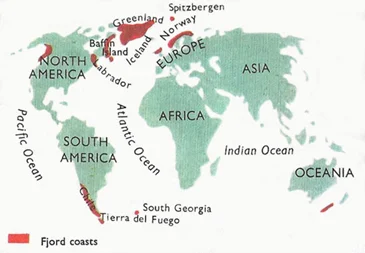Answer:
| Approach:
Introduction
- Start with basic introduction of Fjord.
Body
- Mention Formation of Fjords
- Mention reasons why Fjords constitute some of the Most Picturesque Areas in the World
Conclusion:
- Give appropriate conclusion in this regard
|
Introduction
A fjord is a narrow, deep inlet of seawater bordered by steep cliffs or mountains, extending inland from the ocean. Examples of fjords include Sognefjord, Geirangerfjord, and Lysefjord. These natural wonders boast unique geological features, rich biodiversity, and cultural importance.
Body
Formation of Fjords:
- Glacial Erosion: Fjords took shape during ice ages when massive glaciers carved out deep U-shaped valleys as they moved, eroding the landscape. For instance, Norway’s Sognefjord was created through this glacial activity.
- Isostatic Rebound: As glaciers advance and weigh down the Earth’s crust, the land sinks or subsides under the pressure. When the glaciers retreat, the crust slowly rebounds or rises in response, creating the fjord’s characteristic deep, narrow shape. An example of isostatic rebound is observed in Drammensfjorden.

- Sea-Level Rise: Rising sea levels, often associated with the melting of glaciers and the end of ice ages, lead to the submergence of the glacially carved valleys. This submersion fills the valleys with seawater, forming the fjord. Milford Sound fjord in New Zealand was formed when the sea inundated a glacial valley.
- Tectonic Activity: Fjords can also form due to tectonic activity, where the Earth’s crust undergoes vertical movement, causing the land to sink and allowing seawater to enter, creating fjords.
Reasons Why Fjords Constitute Some of the Most Picturesque Areas in the World:
- Stunning Geological Formations: Fjords are characterized by their unique and picturesque geological formations, including deep, narrow inlets, steep cliffs, and U-shaped valleys, creating a visually striking landscape, as exemplified by the Tracy Arm Fjord in Alaska (USA).
- Lush Greenery and Waterfalls: The rugged cliffs that surround fjords are often adorned with lush green vegetation and punctuated by cascading waterfalls, adding vibrant colors and natural beauty to the scenery. The Milford Sound fjord in New Zealand is an example.
- Contrast of Elements: Fjords offer a captivating contrast between the towering, rocky cliffs and the serene, deep blue waters. This juxtaposition of elements creates a visually arresting and harmonious landscape. Norway’s Geirangerfjord serves as an example.
- Tranquil and Remote Ambiance: Fjords evoke a sense of tranquility and remoteness, with their secluded locations and calm waters providing an ideal atmosphere for relaxation and contemplation. The Hjørundfjord serves as an example of this serene ambiance.
- Rich Biodiversity: Fjords support diverse ecosystems both above and below the water’s surface, with various flora and fauna, including marine life and bird species, enhancing their natural appeal. For instance, the fjords in the Western Antarctic Peninsula (WAP) are intense hotspots of pelagic and benthic productivity and biodiversity.
- Interplay of Light, Water, and Landscape: Fjords offer a dynamic interplay of natural elements—the play of light on the water’s surface, the reflection of towering cliffs, and ever-changing weather conditions, creating a captivating and ever-evolving visual spectacle. Alaska’s Glacier Bay serves as a prominent example.
Conclusion
Fjords are incredibly unique and visually captivating geological features on Earth, shaped through diverse natural processes. Nevertheless, these natural wonders are currently under threat from climate change. By fostering collective efforts, we can work towards securing their existence for future generations.
